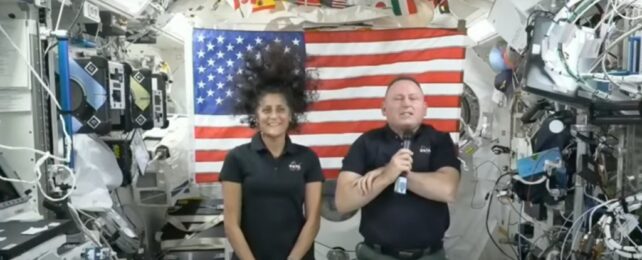NASA astronauts Suni Williams and Butch Wilmore have been on the International Space Station way longer than they'd planned.
The duo flew into space aboard Boeing's Starliner spaceship, testing it out as its first-ever human passengers, on June 5.
They were supposed to stay on the station for eight days, then return home so NASA could certify the spaceship and start using it regularly.
Shortly after they reached space, though, the Boeing spacecraft started glitching. They've been on the ISS ever since, while NASA and Boeing troubleshoot and insist the astronauts are "not stranded."
In a brief call with journalists on Wednesday, Williams and Wilmore finally shared their take on the situation and described what it was like to realize something was wrong with their spaceship.
What astronauts experienced flying on a glitchy spaceship
"Launch was spectacular. I mean, truly amazing," Wilmore said.
The astronauts were pressed back into their seats as the rocket roared through the atmosphere, then experienced the relief of microgravity as Starliner slid into orbit.
Then, in space, they began checking the spaceship's operational capabilities and it "performed unbelievably well," Wilmore said.
Astronauts use a scale of 1 (best) to 10 (worst) to rate spacecraft handling qualities. Wilmore said he's never given a 1 rating before, "but I was tempted."
He added, "It was truly amazing, the precision that this spacecraft held" – until day two of the mission.
As they approached the space station, one of Starliner's 28 Reaction Control System (RCS) thrusters unexpectedly shut down. Then another went offline.
"You could tell the thrust, the control, the capability was degraded. The handling qualities were not the same," Wilmore said.
The astronauts took manual control for over an hour while ground teams were troubleshooting. Ultimately, five RCS thrusters unexpectedly shut down. They got a few thrusters back, Wilmore said, but things weren't the same.
"From that point on, you could tell that the thrust was degraded," though they didn't know why at the time, Wilmore said.
Still, when it came time to dock to the space station, where there were only a few inches of room for error, the spaceship did the job.
"Starliner came right down – in automatic mode at this point – right down the middle, even with the degraded thrusters, which was truly impressive knowing what we know now," Wilmore said.
What's wrong with Boeing's spaceship
NASA has also discovered five leaks in Starliner's helium supply, which is used to pressurize its propulsion system.
NASA is working to understand all the issues on the spacecraft and get more data to ensure the return trip will be safe. Engineers are testing an RCS thruster at NASA's White Sands Test Facility in New Mexico, trying to replicate the unexpected issues that arose mid-flight and ensure the thrusters will perform well on the return journey.
In the meantime, Wilmore and Williams have been busy working on experiments and station maintenance with the other astronauts on the space station.
"We've been thoroughly busy up here integrated right into the crew," Williams said. "About once a week we get to jump into Starliner and talk to our control team there and work through all the nuances that they're working very hard on the ground."
Boeing keeps falling behind
NASA requires Boeing to put Starliner through extensive testing to uncover issues like these. In addition to ground testing, the spaceship had to fly an uncrewed mission to the space station.
The first attempt never reached the space station and experienced multiple failures, but eventually, in a later uncrewed attempt, Starliner reached the ISS.
This crewed mission with Williams and Wilmore is supposed to be the final test to certify the spacecraft for routine astronaut missions, and the astronauts expected to uncover some imperfections.
The leaks and thruster failures are the latest of many issues Boeing has faced with its spacecraft over the years, which has set it far behind competitor SpaceX.
SpaceX's Crew Dragon was developed on a similar timeline through the same NASA program as Starliner, but it finished testing and NASA certification in 2020. It's been flying people to and from the space station ever since.
It's not yet clear how the new issues will affect Boeing's ability to get its spacecraft into the regular space station rotation. Still, Wilmore and Williams expressed confidence.
"We are really satisfied with putting more people in the spacecraft once we get back and we work through all the issues that we've found already," Williams said.
This article was originally published by Business Insider.
More from Business Insider: